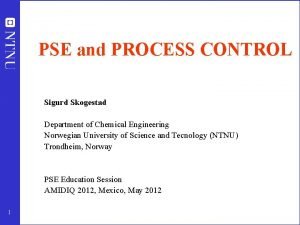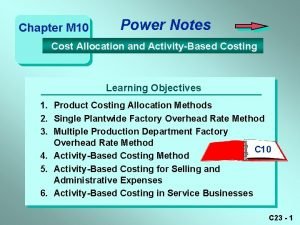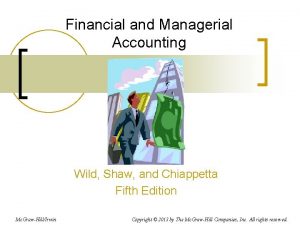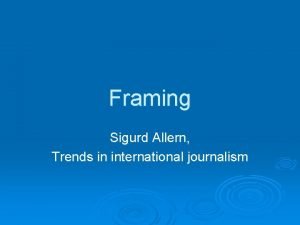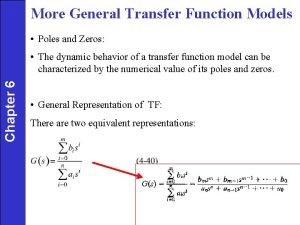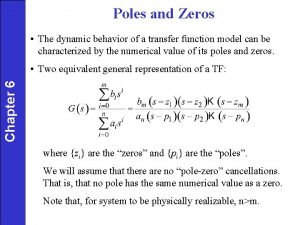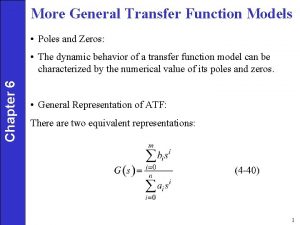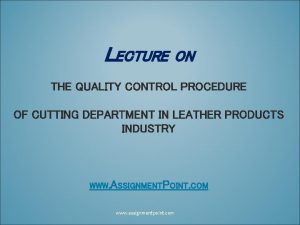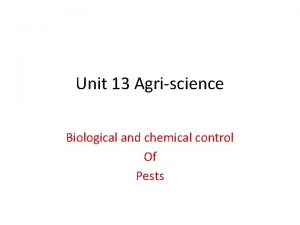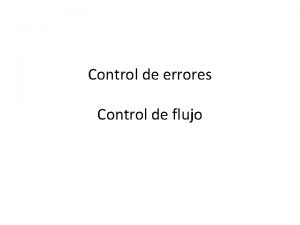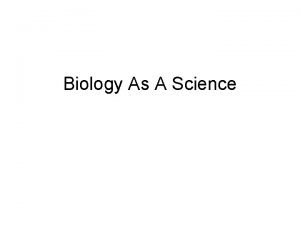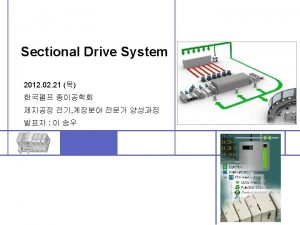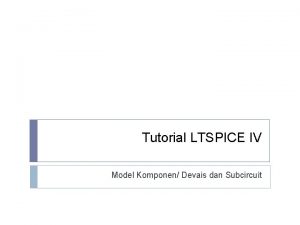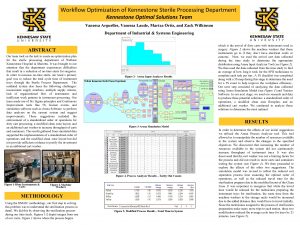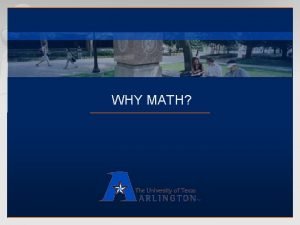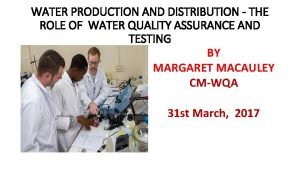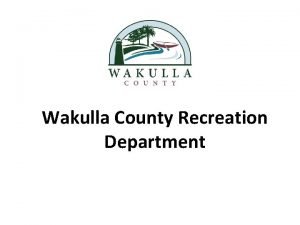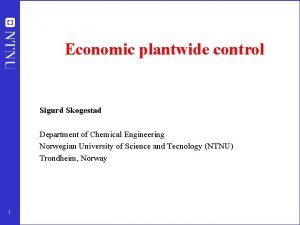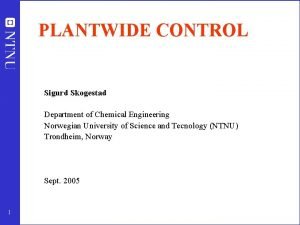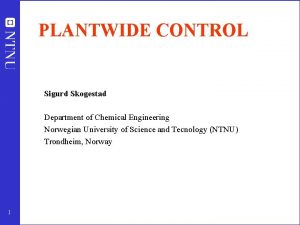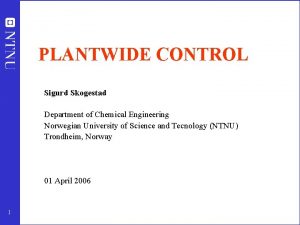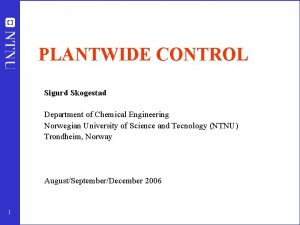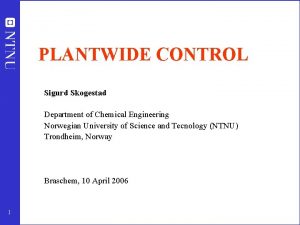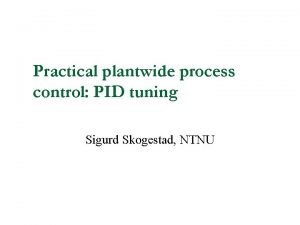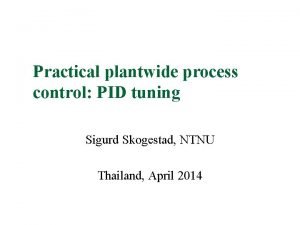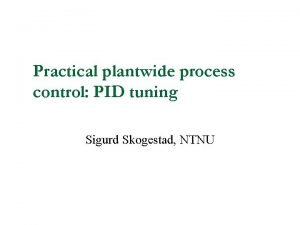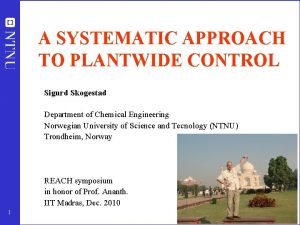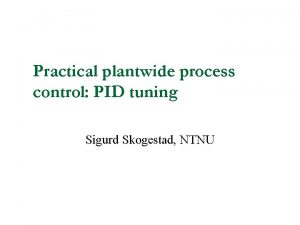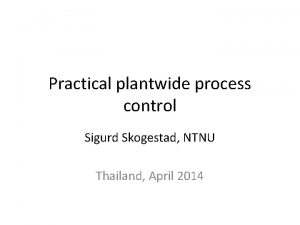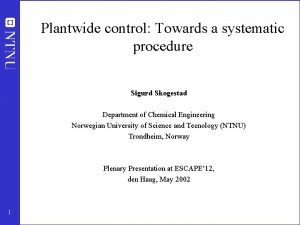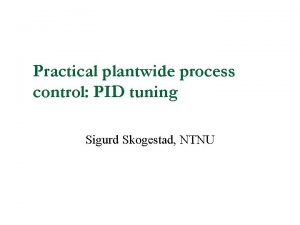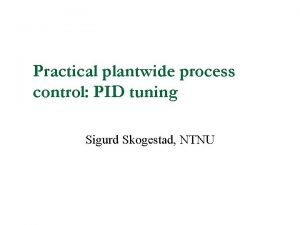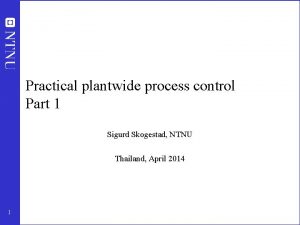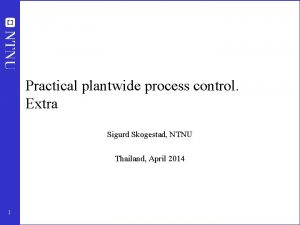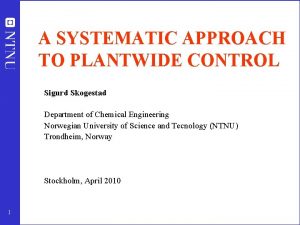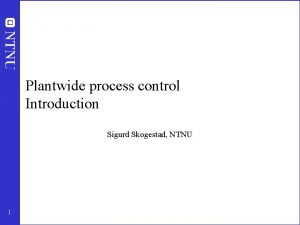Economic plantwide control Sigurd Skogestad Department of Chemical

























![Example. Nullspace Method for Marathon runner u = power, d = slope [degrees] y Example. Nullspace Method for Marathon runner u = power, d = slope [degrees] y](https://slidetodoc.com/presentation_image_h2/083dc3d18daebbf16f6f70897c886ced/image-26.jpg)













- Slides: 39

Economic plantwide control Sigurd Skogestad Department of Chemical Engineering Norwegian University of Science and Tecnology (NTNU) Trondheim, Norway 1

Outline • • • 2 Objectives of control Our paradigm Planwide control procedure based on economics Selection of primary controlled variables (CV 1=y) Example: Runner Example: Guitar Player

How we design a control system for a complete chemical plant? • • 5 Where do we start? What should we control? and why? etc.

In theory: Optimal control and operation Objectives Present state Model of system Approach: CENTRALIZED OPTIMIZER • Model of overall system • Estimate present state • Optimize all degrees of freedom Process control: • Excellent candidate for centralized control Problems: • Model not available • Objectives = ? • Optimization complex • Not robust (difficult to handle uncertainty) • Slow response time 6 (Physical) Degrees of freedom

Academic process control community fish pond Sigurd 7 Optimal centralized solution

Practice: Engineering systems • Most (all? ) large-scale engineering systems are controlled using hierarchies of quite simple controllers – Large-scale chemical plant (refinery) – Commercial aircraft • 100’s of loops • Simple components: PI-control + selectors + cascade + nonlinear fixes + some feedforward Same in biological systems But: Not well understood 8

• Alan Foss (“Critique of chemical process control theory”, AICh. E Journal, 1973): The central issue to be resolved. . . is the determination of control system structure. Which variables should be measured, which inputs should be manipulated and which links should be made between the two sets? There is more than a suspicion that the work of a genius is needed here, for without it the control configuration problem will likely remain in a primitive, hazily stated and wholly unmanageable form. The gap is present indeed, but contrary to the views of many, it is theoretician who must close it. Previous work on plantwide control: 9 • Page Buckley (1964) - Chapter on “Overall process control” (still industrial practice) • Greg Shinskey (1967) – process control systems • Alan Foss (1973) - control system structure • Bill Luyben et al. (1975 - ) – case studies ; “snowball effect” • George Stephanopoulos and Manfred Morari (1980) – synthesis of control structures for chemical processes • Ruel Shinnar (1981 - ) - “dominant variables” • Jim Downs (1991) - Tennessee Eastman challenge problem • Larsson and Skogestad (2000): Review of plantwide control

Main objectives control system 1. Economics: Implementation of acceptable (near-optimal) operation 2. Regulation: Stable operation ARE THESE OBJECTIVES CONFLICTING? • Usually NOT – Different time scales • Stabilization fast time scale – Stabilization doesn’t “use up” any degrees of freedom • • 10 Reference value (setpoint) available for layer above But it “uses up” part of the time window (frequency range)

Our Paradigm Practical operation: Hierarchical structure Manager constraints, prices Process engineer constraints, prices Operator/RTO setpoints Operator/”Advanced control”/MPC setpoints PID-control 11 u = valves

Dealing with complexity Plantwide control: Objectives OBJECTIVE Min J (economics) RTO CV 1 s MPC other variables) CV 2 s PID 12 CV = controlled variable (with setpoint) Follow path (+ look after Stabilize + avoid drift u. The (valves) controlled variables (CVs) interconnect the layers

Optimizer (RTO) Optimally constant valves Always active constraints CV 1 Supervisory controller (MPC) CV 2 s Regulatory controller (PID) CV 2 H Physical inputs (valves) d PROCESS y Stabilized process 13 ny Degrees of freedom for optimization (usually steady-state DOFs), MVopt = CV 1 s Degrees of freedom for supervisory control, MV 1=CV 2 s + unused valves Physical degrees of freedom for stabilizing control, MV 2 = valves (dynamic process inputs)

Control structure design procedure I Top Down (mainly steady-state economics, y 1) • Step 1: Define operational objectives (optimal operation) – Cost function J (to be minimized) – Operational constraints • Step 2: Identify degrees of freedom (MVs) and optimize for expected disturbances • Identify Active constraints • Step 3: Select primary “economic” controlled variables c=y 1 (CV 1 s) • Self-optimizing variables (find H) • Step 4: Where locate throughput manipulator (TPM)? II Bottom Up (dynamics, y 2) • Step 5: Regulatory / stabilizing control (PID layer) – What more to control (y 2; local CV 2 s)? Find H 2 – Pairing of inputs and outputs • Step 6: Supervisory control (MPC layer) • Step 7: Real-time optimization (Do we need it? ) 14 S. Skogestad, ``Control structure design for complete chemical plants'', Computers and Chemical Engineering, 28 (1 -2), 219 -234 (2004). y 1 y 2 MVs Process

Step 1. Define optimal operation (economics) • • What are we going to use our degrees of freedom u (MVs) for? Define scalar cost function J(u, x, d) – u: degrees of freedom (usually steady-state) – d: disturbances – x: states (internal variables) Typical cost function: J = cost feed + cost energy – value products • Optimize operation with respect to u for given d (usually steady-state): minu J(u, x, d) subject to: Model equations: f(u, x, d) = 0 Operational constraints: g(u, x, d) < 0 15

Step S 2. Optimize (a) Identify degrees of freedom (b) Optimize for expected disturbances • • 16 Need good model, usually steady-state Optimization is time consuming! But it is offline Main goal: Identify ACTIVE CONSTRAINTS A good engineer can often guess the active constraints

Step S 3: Implementation of optimal operation • Have found the optimal way of operation. How should it be implemented? • What to control ? (primary CV’s). 1. Active constraints 2. Self-optimizing variables (for unconstrained degrees of freedom) 17

Optimal operation - Runner Optimal operation of runner – Cost to be minimized, J=T – One degree of freedom (u=power) – What should we control? 18

Optimal operation - Runner 1. Optimal operation of Sprinter – 100 m. J=T – Active constraint control: • Maximum speed (”no thinking required”) • CV = power (at max) 19

Optimal operation - Runner 2. Optimal operation of Marathon runner • 40 km. J=T • What should we control? CV=? • Unconstrained optimum J=T uopt 20 u=power

Optimal operation - Runner Self-optimizing control: Marathon (40 km) • Any self-optimizing variable (to control at constant setpoint)? • • 21 c 1 = distance to leader of race c 2 = speed c 3 = heart rate c 4 = level of lactate in muscles

Optimal operation - Runner J=T Conclusion Marathon runner copt c=heart rate select one measurement c = heart rate 22 • CV = heart rate is good “self-optimizing” variable • Simple and robust implementation • Disturbances are indirectly handled by keeping a constant heart rate • May have infrequent adjustment of setpoint (cs)

Step 3. What should we control (c)? Selection of primary controlled variables y 1=c 1. Control active constraints! 2. Unconstrained variables: Control self-optimizing variables! • Old idea (Morari et al. , 1980): “We want to find a function c of the process variables which when held constant, leads automatically to the optimal adjustments of the manipulated variables, and with it, the optimal operating conditions. ” 23

Unconstrained degrees of freedom The ideal “self-optimizing” variable is the gradient, Ju c = J/ u = Ju – Keep gradient at zero for all disturbances (c = Ju=0) – Problem: Usually no measurement of gradient cost J Ju<0 Ju=0 uopt Ju 0 24 u

Never try to control the cost function J (or any other variable that reaches a maximum or minimum at the optimum) J J>Jmin ? Jmin J<Jmin Infeasible u • 25 Better: control its gradient, Ju, or an associated “self-optimizing” variable.

What variable c should we control? (for self-optimizing control) 1. The optimal value of c should be insensitive to disturbances • Small Fc = dcopt/dd 2. c should be easy to measure and control 3. Want “flat” optimum -> The value of c should be sensitive to changes in the degrees of freedom (“large gain”) • Large G = dc/du = HGy Good 26 Good BAD

Nullspace method 27 • Proof. Appendix B in: Jäschke and Skogestad, ”NCO tracking and self-optimizing control in the context of real -time optimization”, Journal of Process Control, 1407 -1416 (2011)
![Example Nullspace Method for Marathon runner u power d slope degrees y Example. Nullspace Method for Marathon runner u = power, d = slope [degrees] y](https://slidetodoc.com/presentation_image_h2/083dc3d18daebbf16f6f70897c886ced/image-26.jpg)
Example. Nullspace Method for Marathon runner u = power, d = slope [degrees] y 1 = hr [beat/min], y 2 = v [m/s] F = dyopt/dd = [0. 25 -0. 2]’ H = [h 1 h 2]] HF = 0 -> h 1 f 1 + h 2 f 2 = 0. 25 h 1 – 0. 2 h 2 = 0 Choose h 1 = 1 -> h 2 = 0. 25/0. 2 = 1. 25 Conclusion: c = hr + 1. 25 v Control c = constant -> hr increases when v decreases (OK uphill!) 28

Step 4. Where set production rate? • Where locale the TPM (throughput manipulator)? – The ”gas pedal” of the process • • 29 Very important! Determines structure of remaining inventory (level) control system Set production rate at (dynamic) bottleneck Link between Top-down and Bottom-up parts

Production rate set at inlet : Inventory control in direction of flow* TPM * Required to get “local-consistent” inventory control 30

Production rate set at outlet: Inventory control opposite flow TPM 31

Production rate set inside process TPM Radiating inventory control around TPM (Georgakis et al. ) 32

Ex am pl e /Q U I Operation of Distillation columns in series • • Cost (J) = - Profit = p. F F + p. V(V 1+V 2) – p. D 1 D 1 – p. D 2 D 2 – p. B 2 B 2 Prices: p. F=p. D 1=PB 2=2 $/mol, p. D 2=2 $/mol, Energy p. V= 0 -0. 2 $/mol (varies) With given feed and pressures: 4 steady-state DOFs. Here: 5 constraints (3 products > 95% + 2 capacity constraints on V) N=41 αAB=1. 33 F ~ 1. 2 mol/s p. F=1 $/mol > 95% A p. D 1=1 $/mol = 4 mol/s < N=41 αBC=1. 5 => 95% B p. D 2=2 $/mol <=2. 4 mol/s > 95% C p. B 2=1 $/mol 33 DOF = Degree Of Freedom Ref. : M. G. Jacobsen and S. Skogestad (2011) QUIZ: What are the expected active constraints? 1. Always. 2. For low energy prices.

SOLUTION QUIZ 1 + new QUIZ 2 Control of Distillation columns in series PC PC LC LC x. B Quiz 2: UNCONSTRAINED CV=? Given MAX V 1 LC 34 Red: Basic regulatory loops CC MAX V 2 LC x. BS=95%

Solution. Control of Distillation columns. Cheap energy PC PC LC LC x. B CC CC x. AS=2. 1% Given MAX V 1 LC 35 MAX V 2 LC x. BS=95%

Distillation example: Not so simple Active constraint regions for two distillation columns in series 1 Mode 1 (expensive energy) Energy price 0 1 [$/mol] Mode 2: operate at BOTTLENECK 2 3 Higher F infeasible because all 5 constraints reached 2 1 0 [mol/s] Mode 1, Cheap energy: 1 remaining unconstrained DOF (L 1) -> Need to find 1 additional CVs (“self-optimizing”) More expensive energy: 3 remaining unconstrained DOFs -> Need to find 3 additional CVs (“self-optimizing”) 36 CV = Controlled Variable

How many active constraints regions? • Maximum: Distillation nc = 5 25 = 32 nc = number of constraints BUT there are usually fewer in practice • Certain constraints are always active (reduces effective nc) • Only nu can be active at a given time x. B always active 2^4 = 16 -1 = 15 nu = number of MVs (inputs) • Certain constraints combinations are not possibe – For example, max and min on the same variable (e. g. flow) 37 • Certain regions are not reached by the assumed disturbance set In practice = 8

CV = Active constraint Example back-off. x. B = purity product > 95% (min. ) D 1 x. B • D 1 directly to customer (hard constraint) – Measurement error (bias): 1% – Control error (variation due to poor control): 2% – Backoff = 1% + 2% = 3% – Setpoint x. Bs= 95 + 3% = 98% (to be safe) – Can reduce backoff with better control (“squeeze and shift”) x. B 40 D 1 to large mixing tank (soft constraint) ± 2% – Measurement error (bias): 1% – Backoff = 1% – Setpoint x. Bs= 95 + 1% = 96% (to be safe) – Do not need to include control error because it averages out in tank 8 • x. B, product

Academic process control community fish pond Sigurd 41 Optimal centralized solution

Summary. Systematic procedure for plantwide control • Start “top-down” with economics: – – – • Step 1: Define operational objectives and identify degrees of freeedom Step 2: Optimize steady-state operation. Step 3 A: Identify active constraints = primary CVs c. Step 3 B: Remaining unconstrained DOFs: Self-optimizing CVs c. Step 4: Where to set the throughput (usually: feed) Regulatory control I: Decide on how to move mass through the plant: • • Regulatory control II: “Bottom-up” stabilization of the plant • • Step 5 A: Propose “local-consistent” inventory (level) control structure. Step 5 B: Control variables to stop “drift” (sensitive temperatures, pressures, . . ) – Pair variables to avoid interaction and saturation Finally: make link between “top-down” and “bottom up”. • Step 6: “Advanced/supervisory control” system (MPC): • • CVs: Active constraints and self-optimizing economic variables + look after variables in layer below (e. g. , avoid saturation) MVs: Setpoints to regulatory control layer. Coordinates within units and possibly between units http: //www. ntnu. no/users/skoge/plantwide 42 cs

Summary and references • The following paper summarizes the procedure: – S. Skogestad, ``Control structure design for complete chemical plants'', Computers and Chemical Engineering, 28 (1 -2), 219 -234 (2004). • There are many approaches to plantwide control as discussed in the following review paper: – T. Larsson and S. Skogestad, ``Plantwide control: A review and a new design procedure'' Modeling, Identification and Control, 21, 209 -240 (2000). • The following paper updates the procedure: – S. Skogestad, ``Economic plantwide control’’, Book chapter in V. Kariwala and V. P. Rangaiah (Eds), Plant-Wide Control: Recent Developments and Applications”, Wiley (2012). • More information: http: //www. ntnu. no/users/skoge/plantwide 43
 Pse in p&id
Pse in p&id How to find plantwide overhead rate
How to find plantwide overhead rate Plantwide overhead rate method
Plantwide overhead rate method Sigurd allern
Sigurd allern Sigurd meldal
Sigurd meldal Sigurd allern
Sigurd allern Skogestad half rule
Skogestad half rule Skogestad half rule
Skogestad half rule Transfer function models
Transfer function models Economic growth vs economic development
Economic growth vs economic development Economic growth and development
Economic growth and development Chapter 1 lesson 2 our economic choices worksheet answers
Chapter 1 lesson 2 our economic choices worksheet answers Section 2 classifying chemical reactions worksheet answers
Section 2 classifying chemical reactions worksheet answers Empirical formula and molecular formula pogil
Empirical formula and molecular formula pogil Section 2 reinforcement classifying chemical reactions
Section 2 reinforcement classifying chemical reactions Chemical reactions section 1 chemical changes
Chemical reactions section 1 chemical changes Modern chemistry chapter 7 test answer key
Modern chemistry chapter 7 test answer key Are kc and kp equal
Are kc and kp equal Cutting quality control
Cutting quality control Agriscience unit 13 completion answers
Agriscience unit 13 completion answers Primary control vs secondary control
Primary control vs secondary control Product vs process
Product vs process Fluid mechanics
Fluid mechanics Stock control e flow control
Stock control e flow control Control volume vs control surface
Control volume vs control surface What is positive and negative control
What is positive and negative control What is a negative control in an experiment
What is a negative control in an experiment Jelaskan tentang error control pada data link control?
Jelaskan tentang error control pada data link control? Control de flujo y control de errores
Control de flujo y control de errores Negative control vs positive control examples
Negative control vs positive control examples Flow and error control
Flow and error control Scalar control vs vector control
Scalar control vs vector control Komponen ltspice
Komponen ltspice Sterile workflow optimization
Sterile workflow optimization Why planning is important
Why planning is important Uta math
Uta math Swot analysis for procurement department
Swot analysis for procurement department Objectives of warehouse operations
Objectives of warehouse operations Wakulla county rec park
Wakulla county rec park Amar telidji university
Amar telidji university
